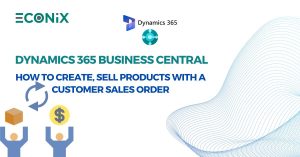Dynamics 365 Project Operations – Project Sales process overview

In this article
- Estimate a sale
- Configure the sales process
- Track revisions to quotes and project plans in the sales cycle
- Track comments and approvals of quotes and project contracts
- Applies To: Project Operations for resource/non-stocked based scenarios, Lite deployment – deal to proforma invoicing
The sales processes that are used in a project-based organization differ from the sales processes that are used in a product-based organization. This is because the sales cycles for project-based organizations are longer and require customized estimate techniques to analyze and create quotes for each deal. Dynamics 365 Project Operations uses some of the following functionality that is used in a sales process:
- A Lead record is used to track the sales process.
- Qualifying leads are tracked as opportunities.
- All related artifacts for an opportunity are accessible. These artifacts include the sales team, stakeholders, probability, rating, sales stages, and business processes.
- Multiple quotes are created for an opportunity.
- A quote is given the status, Closed as Won to create a sales order. In Project Operations, the sales order is customized and called a project contract.
Estimate a sale
The value of a sale can be estimated based on projects that have previously been delivered and the complexity of the projects. For projects that involve extensions to previous projects, or projects where the vendor’s expertise is high and well-known work templates are used, you can use a simpler estimation process. More complex projects usually have a longer purchase process. Therefore, there are more stages in the sales estimation process. Early in the process, the sales team uses the input of account managers and subject matter experts (SMEs) to create a high-level estimate for each distinct component of work that is quoted. These components of work are represented by quote lines.
You can create a high-level estimate of the quote. Eventually, this high-level estimate will be replaced by a more detailed estimate that is based on a project plan that you create by using the standardized project templates. These templates help you build a schedule and determine monetary values on the quote and its components (quote lines).
You can create multiple quotes for a project and group them under a single opportunity record. Eventually, one of the quotes is marked Closed as Won, and a project contract or statement of work (SOW) is created. A project contract holds the contracted value for each component (contract line) that is accepted by the customer for delivery. An SOW is usually created as a Microsoft Word document. All invoices that are sent to the customer over the course of the project’s delivery reference the project contract or SOW.
You can also create alternate quotes under one opportunity record or set up the system so that a project contract is created when a quote is won. In this case, you can attach a Word document that represents the SOW to the project contract record.
Configure the sales process
You can use business process flows to configure your sales process. These flows provide a guided visual interface to move deals forward through the stages of the sales process.
For example, your company might have the following six stages in the sales process:
- Qualify
- Estimate
- Internal review
- Contract
- Deliver
- Close
Your organization might use different entities to represent the same deal as it evolves. Early in the sales process, a deal is represented by the Opportunity entity. As time passes and more details emerge, you might use high-level estimates to create one or more quotes. If one of these quotes is reviewed by internal and customer stakeholders, the Quote entity represents the deal. After the customer accepts the quote, a project contract or SOW represents the deal. To support this behavior, BPFs are structured so that each stage in the process is linked to a different database table.
The Qualify stage in the sales process can be backed by an Opportunity entity. The Estimate and Internal Review stages can be backed by a Quote entity. The Contract, Delivery, and Close stages can be backed by a Project Contract entity.
As you move deals through the stages, you’re prompted to create the appropriate entity record to help and guide you through the process. The stages can be conditional. For example, if you require an internal review of a quote only if the quote uses a custom price list, you can configure that condition in the appropriate stage of the business process. The Internal Review stage is then shown only for quotes that use a custom price list. For all other deals and quotes, the Estimate stage is followed by the Contract stage.
Track revisions to quotes and project plans in the sales cycle
In Project Operations, you can’t track revisions that are made to a quote. Instead, you must mark the existing quote Closed as Lost and then create a new quote. You can copy a quote or clone a project-based quote.
Track comments and approvals of quotes and project contracts
You can manage the review and approval of quotes and project contracts by using the record wall and posts. Your organization can create custom workflows and plug-ins to assign, redirect, escalate, and manage notifications of review and the approval of work items.
LATEST INSIGHTS
-
Business Central customize pages for profiles
-
Adding Regional Formats to Reports in Dynamics 365 Business Central
-
Dynamics 365 Business Central – How to create Sell Products with a Customer Sales Order
-
Cash Flow in Dynamics Business Central Overview
-
Understand Location cards in D365 Business Central
REQUEST
FOR A CALL BACK
Provide discussion information and we’ll get back to you as soon as possible
Customer Satisfaction
Address
Corporate Office
Econix InfoTech Ltd.
10B-111 REGINA RD, WOODBRIDGE, ON L4L 8N5, Canada
Request a Business Consultation
Subscribe Newsletter
Copyright© 2018-2024 ECONIX InfoTech & Group Companies. All Rights Reserved



